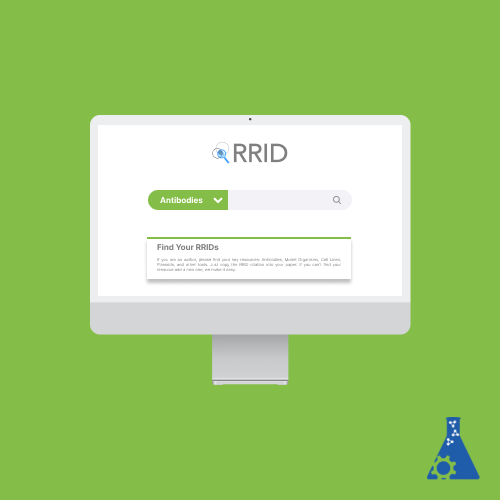TakTic
Role
Designer, Developer
Platforms
Desktop, Mobile
Areas
Design, Research, Development
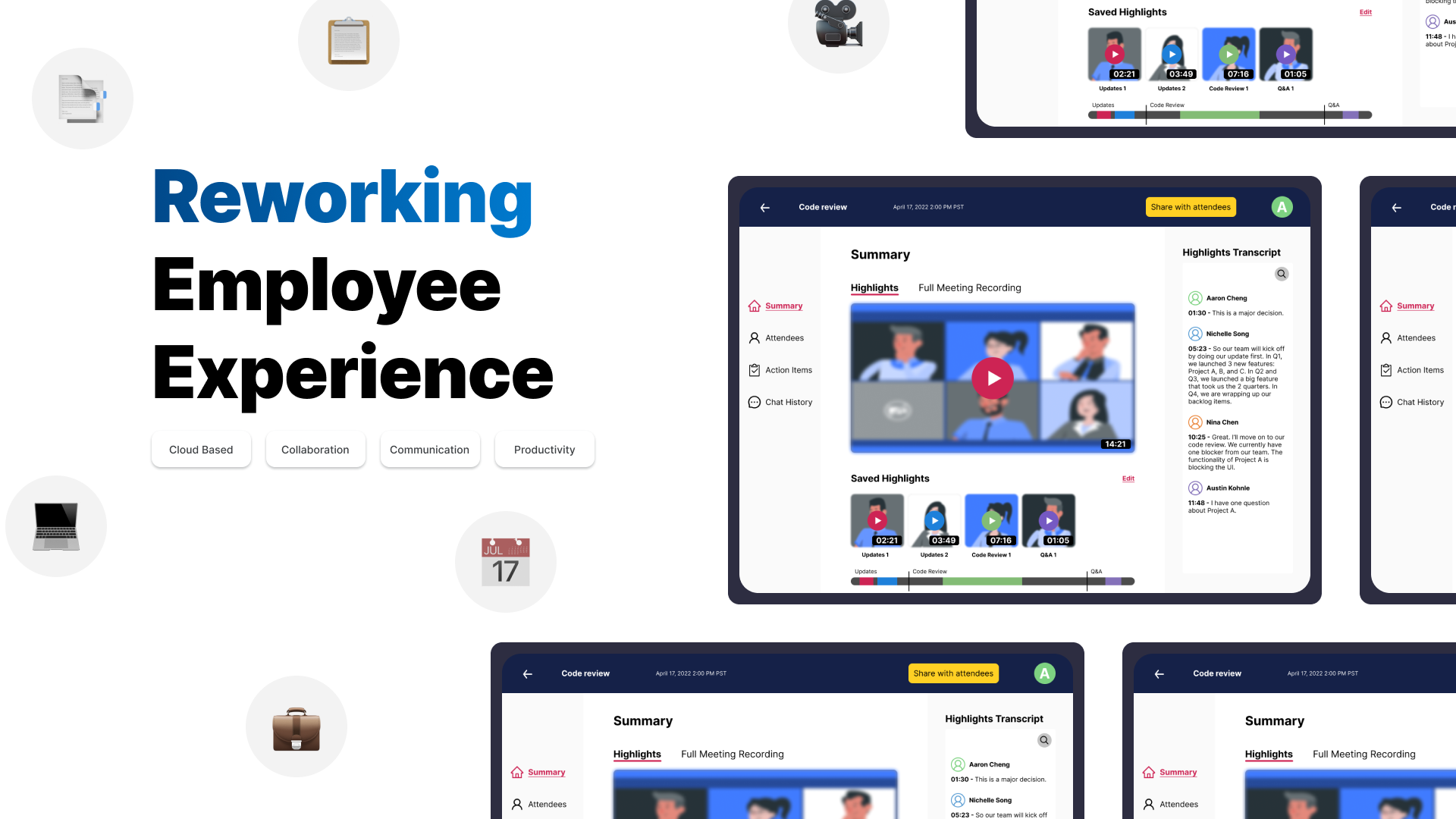
Overview
PROBLEM
The pandemic negatively impacted employee experience. With the rise of virtual and hybrid work, organizations saw a decrease in employee experience and well-being and this is due to:
- Zoom fatigue
- Too many meetings
- Meetings starting and ending late
- Irrelevant meetings
- Unproductive meetings with unclear structure and agendas
SOLUTION
Design a platform-agnostic capability that will sit on top of existing meeting platforms, such as Zoom and Microsoft Teams.
TASK
Design and develop a working prototype that reworks the way how we navigate meetings at work
TOOLS
Figma, CoSpaces, Adobe Creative Suite, Google Suite, Miro
Research
51
5
12
Survey Responses
Interviews
Literature Reviews
We originally started by scoping down our project to one aspect of employee experience. To do this, we implemented a survey, several interviews, and literature reviews that eventually led us to explore VR solutions to improve mental well-being. The space, however, was complex and nuanced due to time constraints. In light of this, our team decided to pivot halfway through the project and focused on a deliverable based on design usability and solution effectiveness.
Survey
Executive Bullet Points
- Virtual meetings were the number one workplace activity participants wanted improvements on due to aspects such as high frequency and low productivity
- Participants ranked mental well-being as the most important aspect of employee experience
Interviews
Executive Bullet Points
- Remote work environments had negative impacts such as degraded social interaction and video fatigue
- Remote meetings affected the mental health of participants due to frequency and lack of productivity or participation
Personas
The three personas represent the culmination of insights surfaced from research, enriched by the principle of “marginally minded,” and constructed as a broader unit representative of a hybrid/remote team.
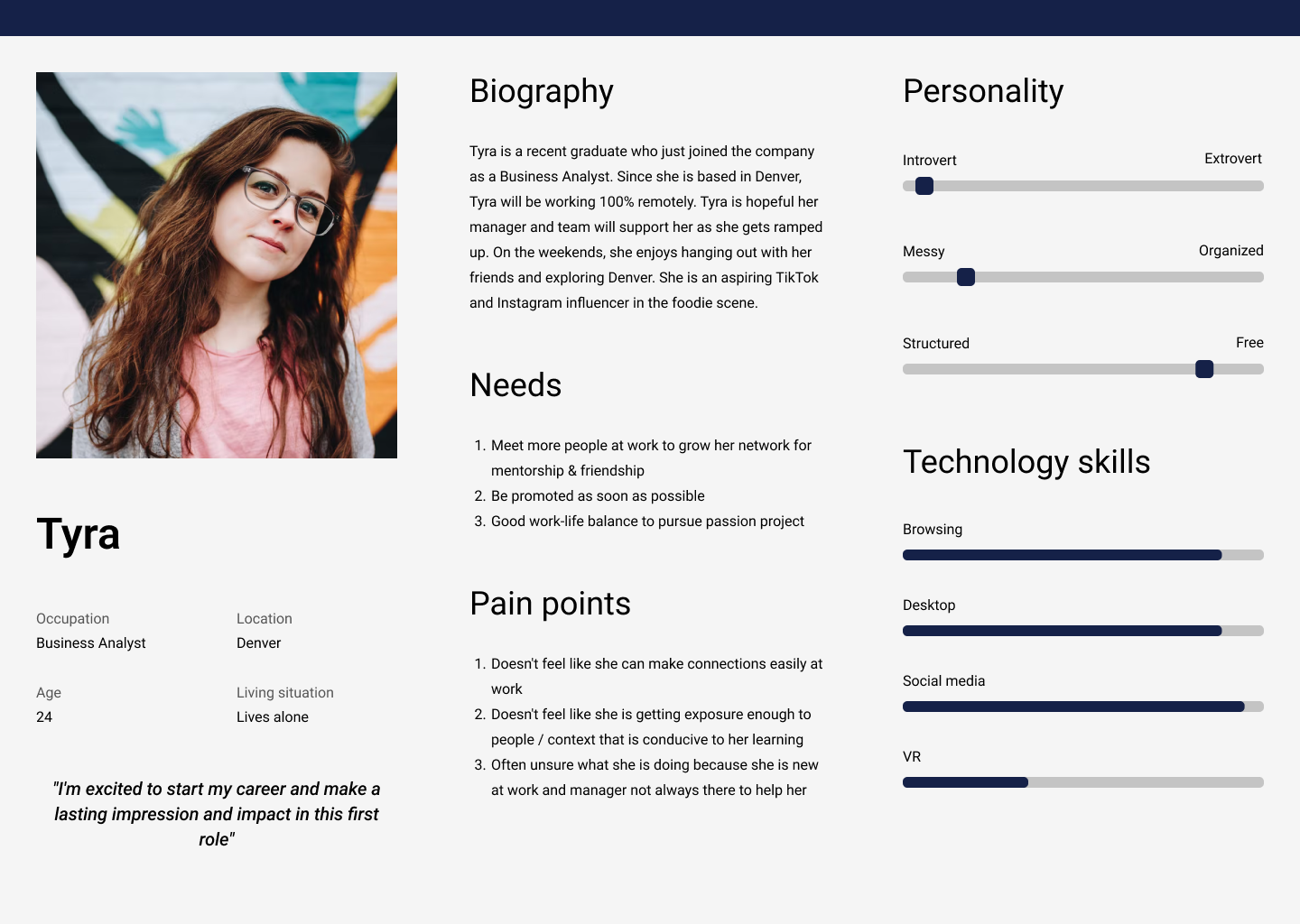


DESIGN PROBLEM
How might we improve mental well-being through redesigning the way meetings are conducted remotely?
Ideation
After pivoting from our initially proposed VR solution, we did a whiteboarding session to recap findings from our generative research. We summarized that meetings are stressful and negatively affect employees’ mental well-being. This stress typically occurs during meetings due to Zoom fatigue, high frequency and duration, and lack of productivity due to poor planning.
Taking insights from the whiteboarding exercise, we then did a solutioning exercise to further scope down our ideas and to make sure our solution is aligned with our design problem.
Whiteboarding
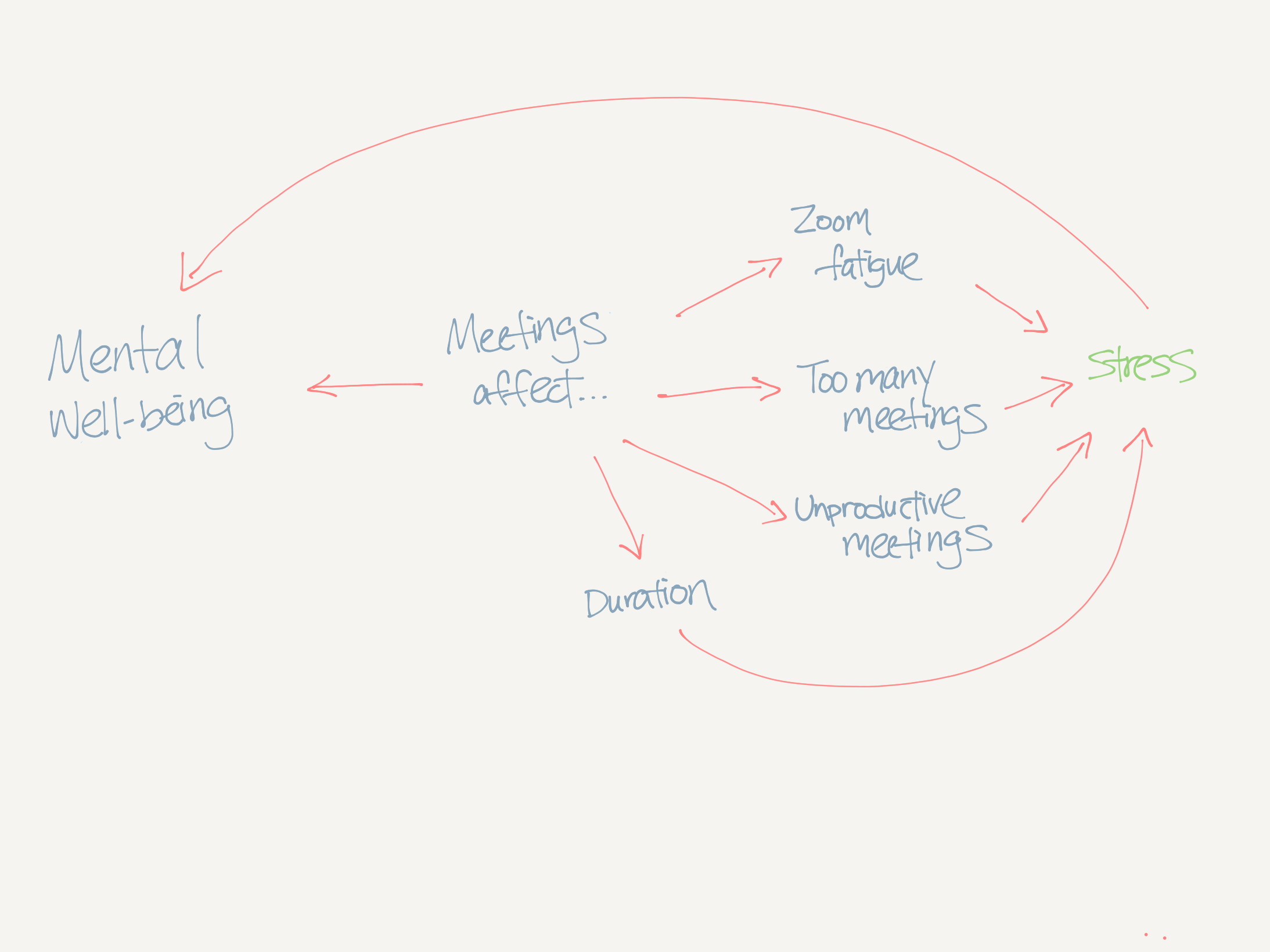
Solutioning

Sketches
Our top ideas involved being able to recap meetings for employees who were able to attend and were not able to attend, both through watching the recording and reading the transcript. Taking these ideas, we individually sketched out a couple of screens to visualize how they would look.
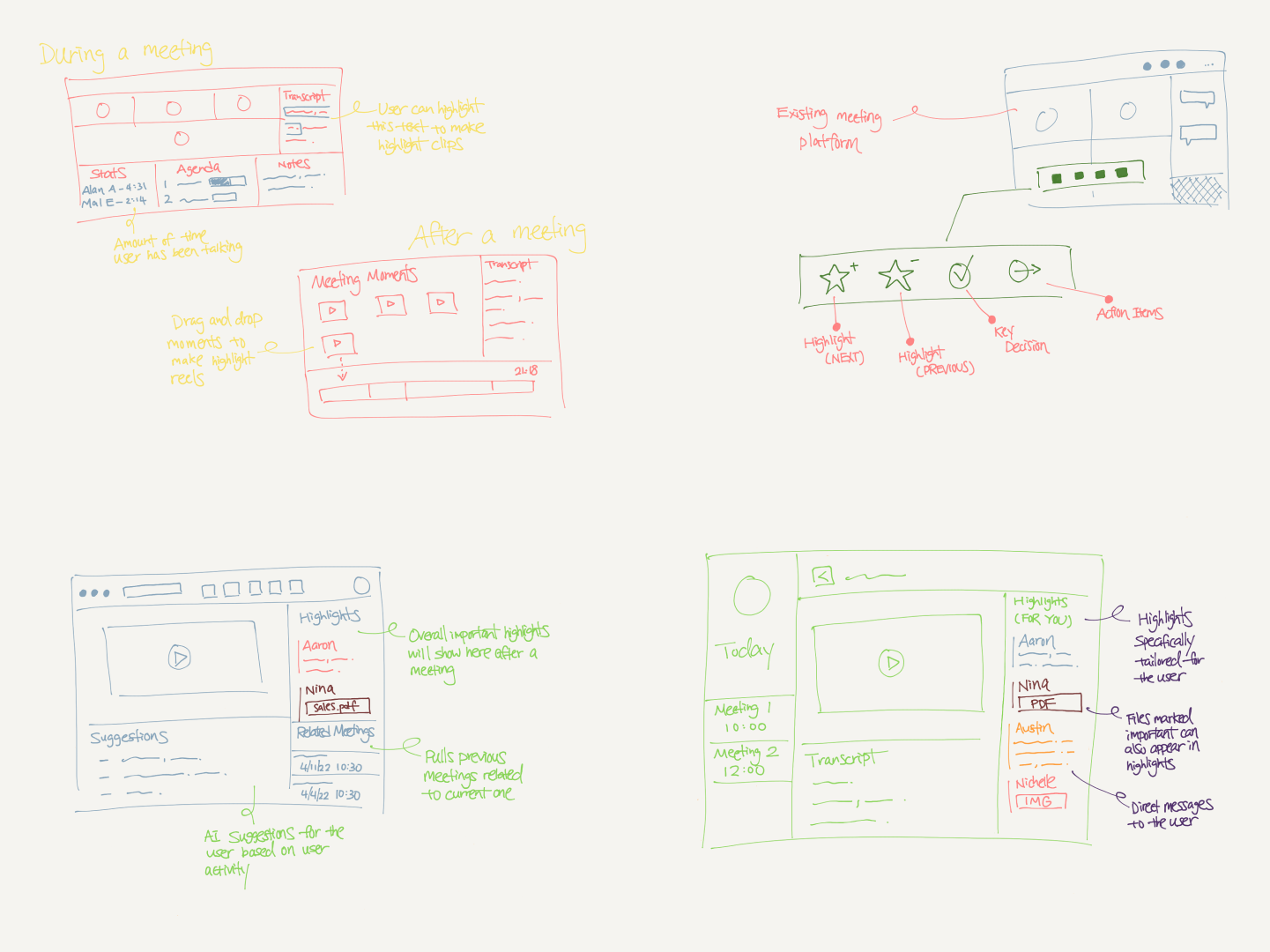
Wireframes
The following screens show the initial wireframes we used to validate our designs.
Before the meeting
Our design encourages the meeting organizer to set up an agenda before sending out the meeting invites. Setting up an agenda helps the meeting organizer to prepare the topics to stay productive. It also helps the meeting attendee to join the call and understand the goal of the meeting.

This tool will recommend the meeting organizer to set up time blocks for their meeting agenda.

Once the meeting organizer types in the time block field, the tool will provide a visualization of the agenda.
During the meeting
Once the meeting recording starts, everyone in the meeting can see the agenda timeline and agenda blocks at the bottom of their screen. The tool can also capture who’s talking and for how long. This visualization lets the speaker and everyone in the meeting help each other to stay on the appropriate topic.

Meeting starts. The tool indicates the current speaker and time blocks for the rest of the meeting.
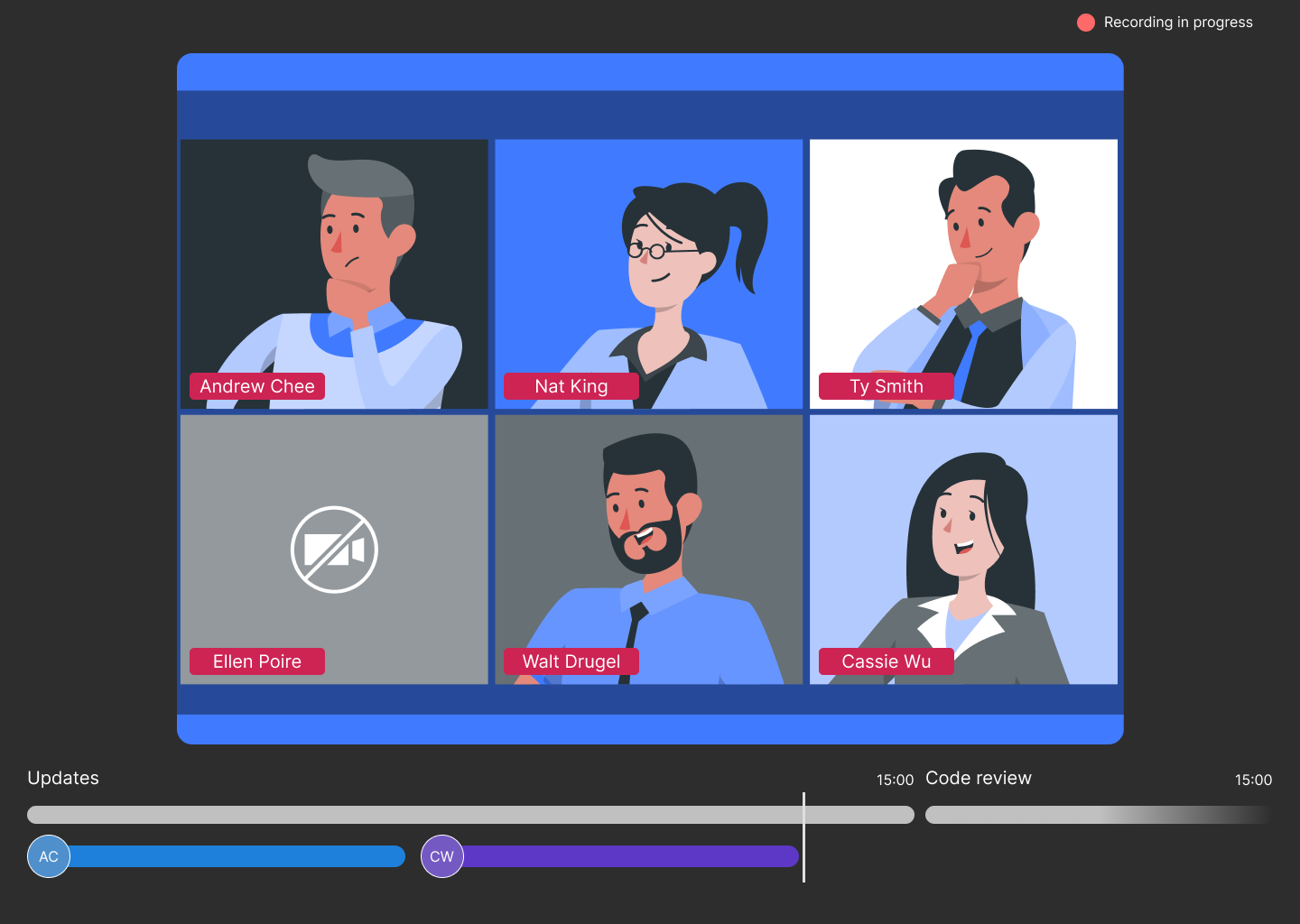
Meeting in progress. Different speakers will be visualized in the meeting timeline.

Everyone at the meeting can see the option to add meeting highlights by hovering over a speaker’s timeline.
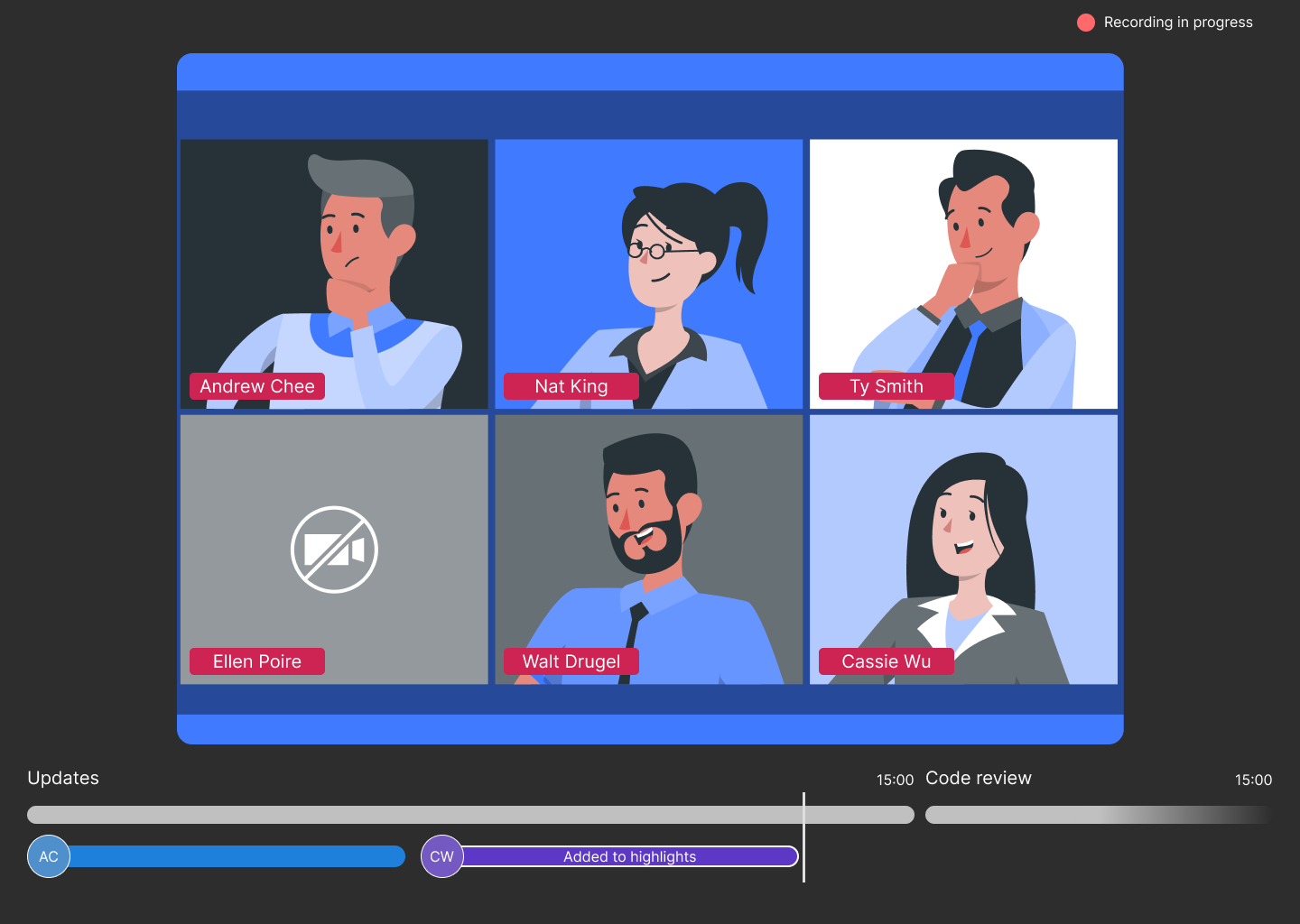
Highlights can be added by clicking on the speakers’ timeline. Once added, a clip will be accessible at the end of the meeting.
After the meeting
After the meeting, the meeting organizer is presented with the meeting highlights the attendees collectively put together during the meeting. At this stage, the meeting organizer can review the highlights before sharing them with attendees.
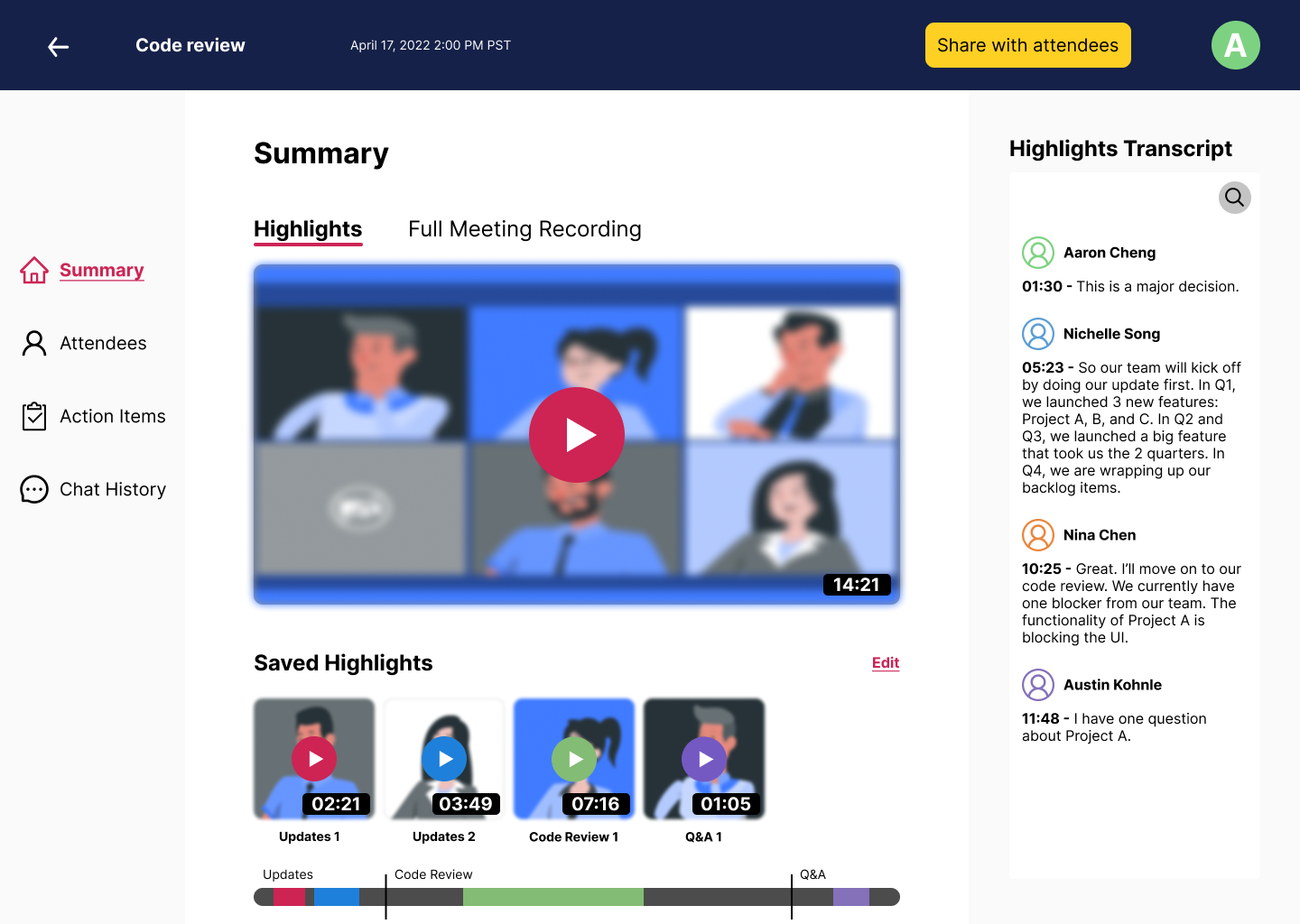
The meeting organizer is able to see the created highlights before sending them out.

The meeting organizer can also see the full meeting recording to reference as needed.
Validation
We conducted a usability study consisting of 3 scenarios and a post-scenario survey. All 5 participants were randomly selected from the users who completed our survey.
Before the meeting
Usability
5 out of 5 participants were able to add the agenda for the meeting within the tool.
Concept Feedback
Participants suggested providing a bigger container to add more descriptions or notes about the agenda item since most meeting agendas require more explanations for the attendees to have more context.
During the meeting
Usability
4 out of 5 participants were able to add the highlights during the meeting successfully with no confusion.
Concept Feedback
When asked if there are any concerns about creating one, consolidated highlight summary for a meeting for everyone, there was a division in opinions. Although the majority of participants liked how everyone in the meeting could contribute to creating the highlight, a couple of participants thought what each person thinks a “highlight” should be is different, therefore everyone should create their own.
After the meeting
Usability
5 out of 5 participants were able to understand the difference between viewing the highlights video and transcript vs. the full recording video and transcript.
Concept Feedback
More feedback was around preference. A couple of participants mentioned they would rather read the transcript than have to watch the highlight video just to save time.
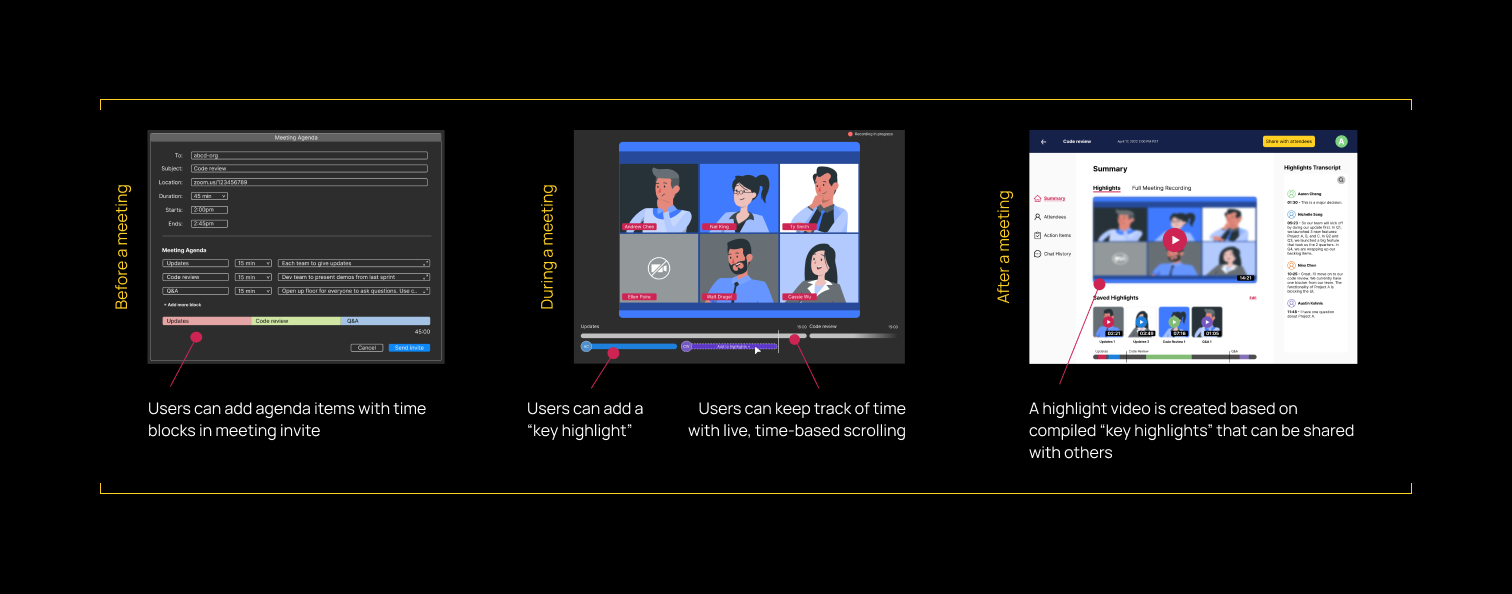
Final Concept
Our solution will sit on top of the existing meeting platforms, such as Zoom and Microsoft Teams, to help users:
- Create meeting agenda and associated time blocks
- Save notable moments as meeting highlights
- Review and share meeting summaries with meeting attendees and others who couldn’t make the meeting
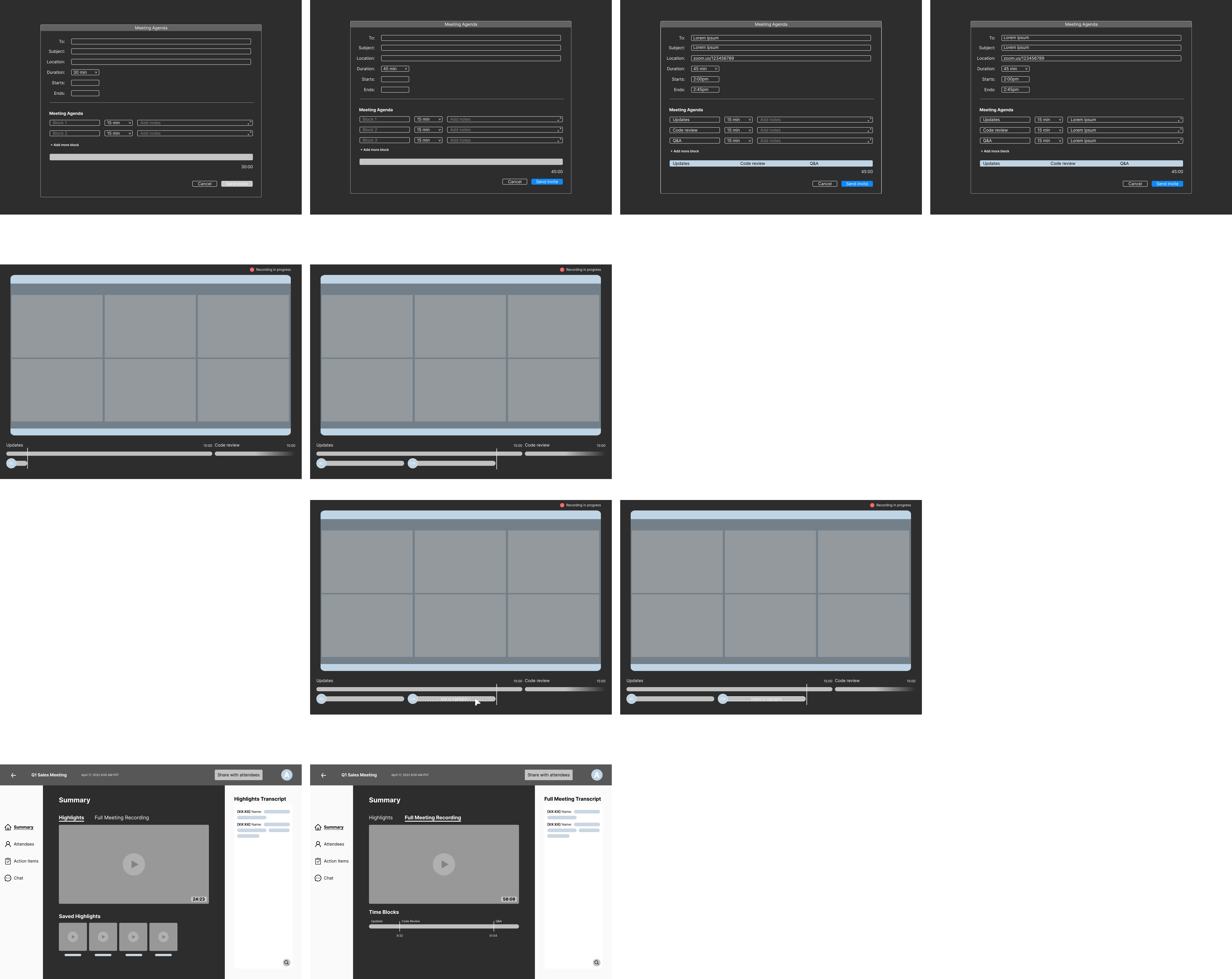
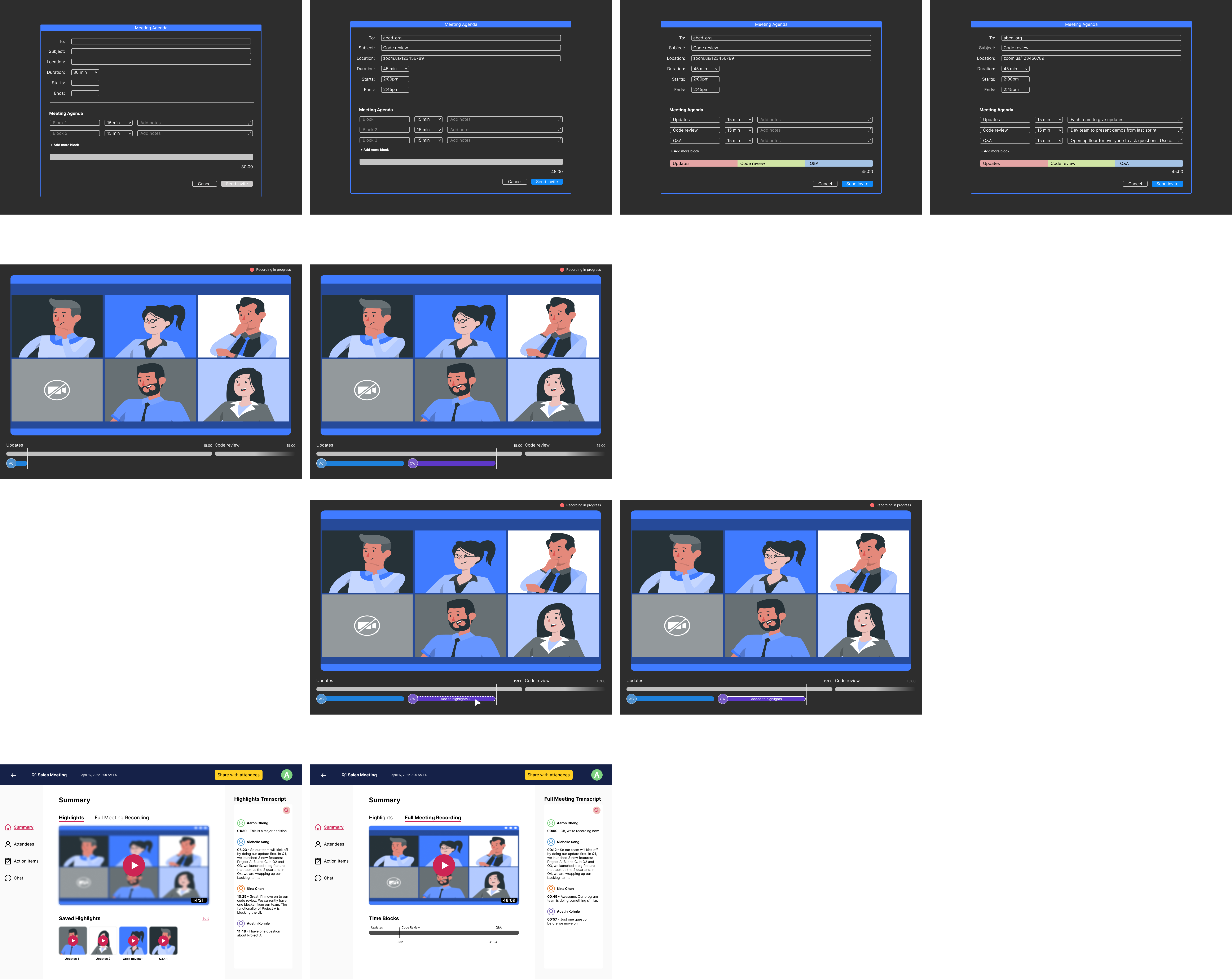
Future
The following wireframes show elements of the design that should be evaluated for future iterations. Most of these were feedback received from participants or pieces of the design that we explored but deemed out of scope for the minimum viable product. In the near future, we also plan to explore the VR meeting space. Before our pivot, we built an initial prototype that refines the experience and identifies the business, design, and technical requirements.
Participant Info Card
From research, we’ve heard from participants that they are often in meetings where they don’t know everyone on the call. Participant info card will give an overview of their colleague or client’s name, role, and department.
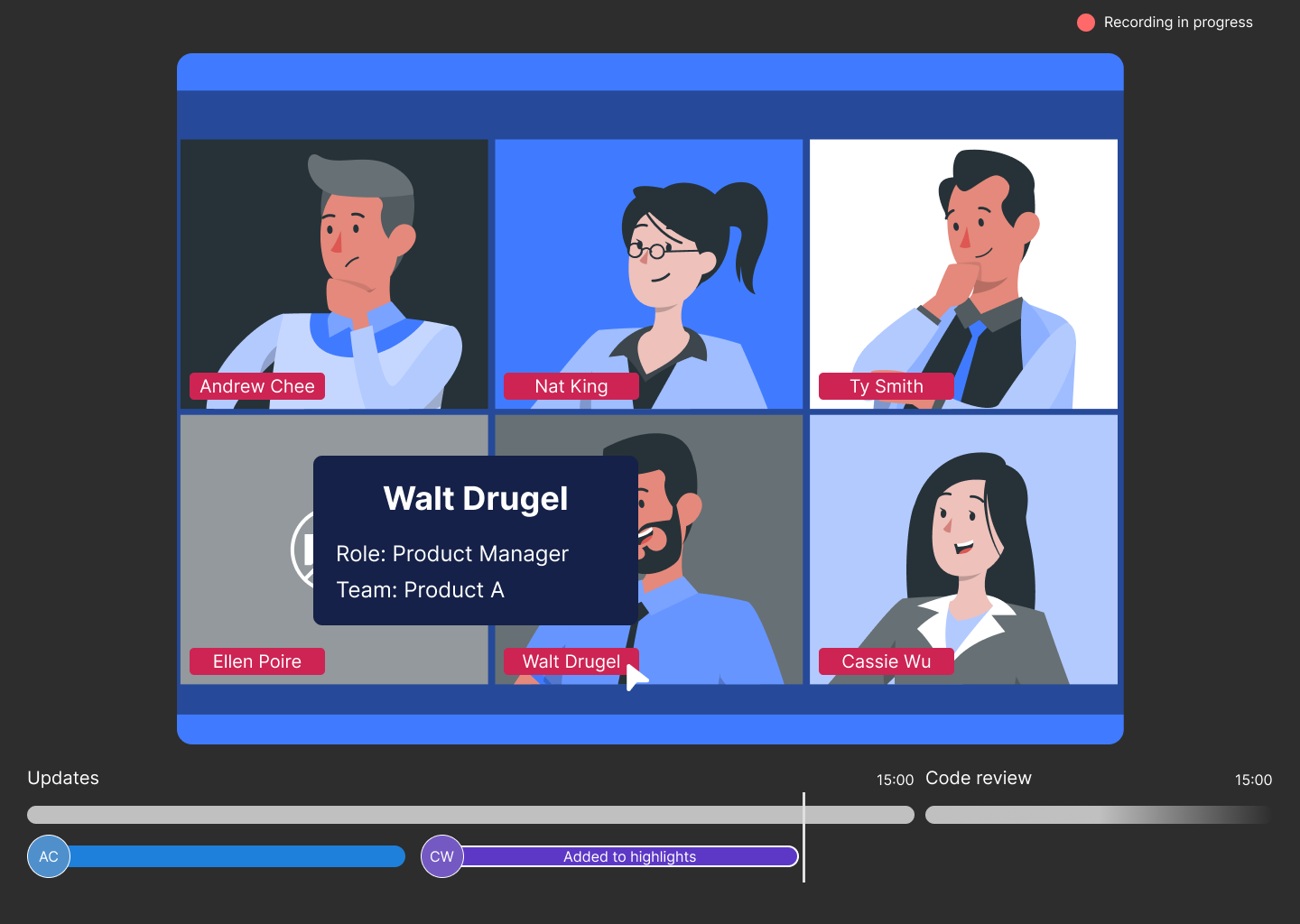
Metric Dashboard with Tips
In a future version, we’ll research what kind of metrics will be most useful for the users to understand how they should manage meetings to positively support their mental well-being.





